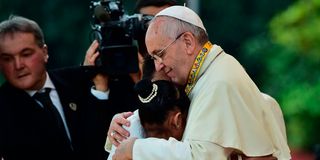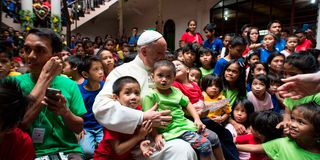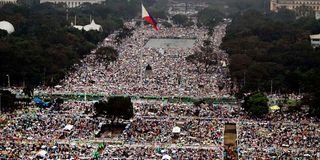Premium
Fr Steven Ochieng: Pope Francis' humble presence in Manila

Pope Francis embraces two children on January 18, 2015 during his visit to the University of Santo Tomas in Manila, The Philippines.
I was driving along the potholed roads of Malawi when the news of Pope Francis's death reached me. It struck like a sharp pain in my heart—just the day before, I had seen footage of him greeting multitudes and blessing the world on Easter Sunday. He had appeared to be recovering, or so it seemed. The news came as a genuine shock. I pulled the vehicle over, and we paused to say a prayer together.
As we sat there, memories began flooding my mind. Most vivid was my encounter with him during his visit to the Pontifical University of Santo Tomas (UST) in Manila, January 2015. I had joined the massive crowds gathering to see him, arriving at the campus at 4am, only to find throngs of people already there. By the time his motorcade arrived at 10am, we had been waiting for six hours in anticipation.
The wait proved worthwhile. Pope Francis's humble presence was immediately evident. Despite being one of the most influential religious leaders in the world, there was nothing pretentious about him. He carried himself with the simplicity and approachability that would become hallmarks of his papacy.

Pope Francis meets children at an event in Manila on January 16, 2015.
His address to the university community was profoundly moving. I can still recall his words with remarkable clarity. He spoke about a tragedy that had occurred during his Mass in Tacloban, where strong winds had broken something that struck and killed a young girl. He paused to say a pray for her. Then he listened with attention to the testimonies of children from depressed communities; With deep emotion, he posed the haunting question: "Why do children suffer?" His answer revealed his profound humanity—"The heart that feels is the heart that suffers". He explained that it was only when Jesus Christ cried that He was able to understand our human drama. Pope Francis emphasised that we need to cry to truly feel the pain of others, that our tears are essential to developing genuine compassion.
Among the many insights he shared that day, his reflection that "crying is good as it washes our eyes to see better" has stayed with me through the years. This poetic yet deeply meaningful observation exemplified his approach to faith and humanity: embracing our emotions as pathways to greater clarity and understanding.
What struck me most about Pope Francis during this encounter was how he seemed to dissolve the barriers between the papal office and ordinary people. He didn't just speak to the crowd; he connected with us. His gestures were natural, his smile genuine, and his attention fully present. When he listened to questions from students, he did so with an attentiveness that made each speaker feel valued.
In a world often focused on pomp and circumstance, Pope Francis demonstrated that true leadership emerges from humility. He showed that the most powerful way to touch people's hearts is not through grandeur but through authentic presence and compassion.

An aerial handout photo taken shows millions of faithful attending a mass by Pope Francis at a park during his visit to Manila.
That day at UST Manila revealed the essence of who Pope Francis was—a shepherd who truly lived among his flock rather than above them. This memory, vivid in my mind as I sat in my vehicle on that Malawian road, brought both comfort and deeper sadness at his passing. The world had lost not just a religious leader, but a genuine example of humble service.
As I eventually resumed my journey along those rough roads, I carried with me the lessons of that first encounter—that true greatness lies in simplicity, that leadership begins with listening, and that sometimes, our tears help us see the world more clearly.

